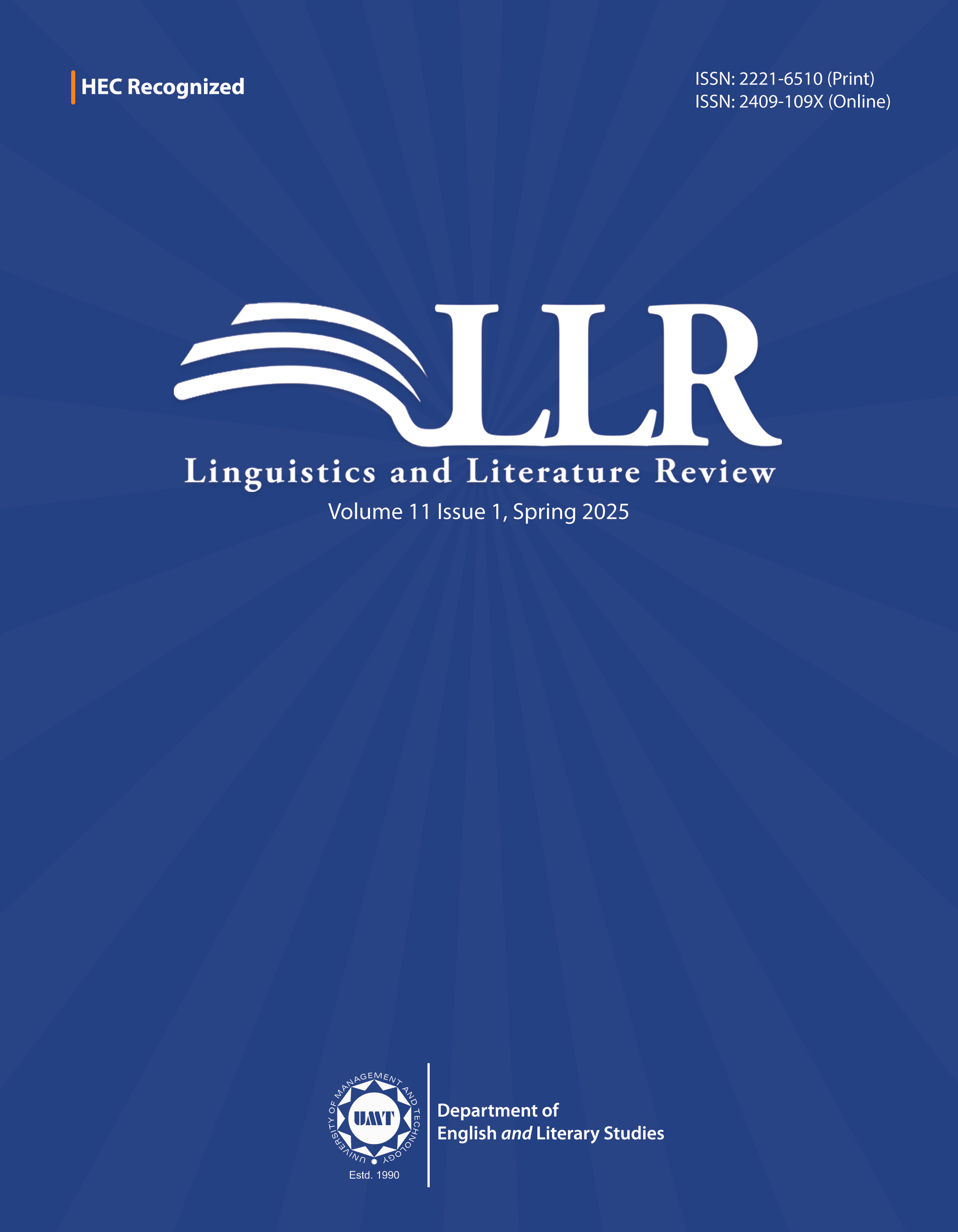From ‘Palm Fields to Palm Oil’: Call for Environmental Justice in How Beautiful We Were
Abstract
 Abstract Views: 0
Abstract Views: 0
Ecology and literature hold immense importance at the heart of critical scholarship within the broader corpus of Environmental Humanities because they open up new lines of critical inquiry and foster critical consciousness among both the masses and academia at large. This paper demonstrates the way How Beautiful We Were (2022) portrays the African village named Kosawa, where the indigenous African farmers and their families were jeopardized by having their indigenous natural resources exploited. This study analyzes how the palm trees serve as a cultural heritage for the farmers in the remote village, which was barred from the outer world. However, they still cherished the indigenous resources to make a harmonious relationship with nature, which is analyzed by the theoretical insight of Cultural Ecology by Q.Mark Sutton. The study also addresses that the colonial powers of the West have marginalized the ecological landscape and the familial fabric of the poor peasants, and the female farmers suffered subjugation and oppression at the hands of the glossy illusions that the West has impinged on their minds in the spurious ambiance of development. I analyze that the poor peasants pleaded and utilized their natural indigenous resources for the higher officials, but their voices were muffled and reduced to invisibility. My study is the emblem of the call for environmental justice from the periphery of the crunched remote region of Africa, where African farmers were grappling with diseases, exploitation of resources, and female oppression.
Downloads
References
Beinart, W. (2000). African history and environmental history. African Affairs, 99(395), 269–302.
Besky, S., & Padwe, J. (2016). Placing plants in territory. Environment and Society, 7(1), 9–28. https://doi.org/10.3167/ares.2016.070102
Blažan, S. (2021). Haunted nature: Entanglements of the human and the nonhuman. Palgrave Macmillan. https://doi.org/10.1007/978-3-030-81869-2
Boyd, L. W., Jr. (1996). The end of Hawaii's plantations: Back to the future? The ANNALS of the American Academy of Political and Social Science, 544(1), 95–110. https://doi.org/10.1177/0002716296544001008
Buckridge, S. O. (2003). The role of plant substances in Jamaican slave dress. Caribbean Quarterly, 49(3), 61–73. https://doi.org/10.1177/0002716296544001008
Caminero-Santangelo, B. (2014). Different shades of green: African literature, environmental justice, and political ecology. University of Virginia Press.
Carruthers, J. (2004). Africa: Histories, ecologies and societies. Environment and History, 10(4), 379–406. https://doi.org/10.3197/0967340042772649
Clary, R., & Wandersee, J. (2011). Our human-plant connection. Science Scope, 34(8), 32–37.
Davis, M. (2002). Late Victorian holocausts: El Niño famines and the making of the third world. Verso Books.
De Carvalho, L. M., Fernandes, F. M., Nunes, M. D. F., & Mills, C. (2012). The queen and the flower power—the symbolic use of plants in the court of St. James's, United Kingdom. Harvard Papers in Botany, 17(2), 317–322. https://doi.org/10.3100/025.017.0212
Dobson, A. (1998). Justice and the environment: Conceptions of environmental sustainability and theories of distributive justice. Clarendon Press.
Falkner, R. (2013). The handbook of global climate and environment policy. Wiley Blackwell.
Gaard, G. (2002). Vegetarian ecofeminism: A review essay. Frontiers: A Journal of Women Studies, 23(3), 117–146.
Gibson, P., & Gagliano, M. (2017). The feminist plant: Changing relations with the water lily. Ethics and the Environment, 22(2), 125–147. https://doi.org/10.2979/ethicsenviro.22.2.06
Guha, R. (2014). Environmentalism: A global history. Penguin UK.
Kandeler, R., & Ullrich, W. R. (2009). Symbolism of plants: Examples from European-Mediterranean culture presented with biology and history of art: July: Lotus. Journal of Experimental Botany, 60(9), 2461–2464. https://doi.org/10.1093/jxb/erp166
Kosek, J. (2010). Ecologies of empire: On the new uses of the honeybee. Cultural Anthropology, 25(4), 650–678. https://doi.org/10.1111/j.1548-1360.2010.01073.x
Krosnick, S. E., Baker, J. C., & Moore, K. R. (2018). The pet plant project: Treating plant blindness by making plants personal. The American Biology Teacher, 80(5), 339–345. https://doi.org/10.1525/abt.2018.80.5.339
Kunnie, J. E. (2013). Restoring Africa’s heartland: Earth, women, culture, and community. Journal of Black Studies, 44(4), 426–448. https://doi.org/10.1177/0021934713489880
Mbue, I. (2022). How beautiful we were: A novel. Random House Trade Paperbacks.
Mortensen, F. H. (2008). The little mermaid: Icon and Disneyfication. Scandinavian Studies, 80(4), 437–454.
Naïm, S. (2000, July 15–17). Fenugreek in the culture of the highlands of Yemen [Paper presentation]. Proceedings of the Seminar for Arabian Studies, London, UK.
Norgaard, K. M. (1999). Moon phases, menstrual cycles, and Mother Earth: The construction of relationship between women and nature. Ethics & the Environment, 4(2), 197–209.
Pak, C. (2016). Terraforming: Ecopolitical transformations and environmentalism in science fiction. Liverpool University Press.
Pedersen, M. (2019). Malaga Island. The History Teacher, 53(1), 137–169.
Plahe, J. K., Hawkes, S., & Ponnamperuma, S. (2013). The corporate food regime and food sovereignty in the Pacific Islands. The Contemporary Pacific, 25(2), 309–338.
Sachs, C. E. (2018). Gendered fields: Rural women, agriculture, and environment. Routledge.
Salman, A., & Iqbal, N. (2007). Ecofeminist movements—from the North to the South [with comments]. The Pakistan Development Review, 46(4), 853–864.
Sarafa, R. (2004). Roots of conflict: Felling Palestine's olive trees. Harvard International Review, 26(1), 13–14.
Sutton, M. Q., & Anderson, E. N. (2020). An introduction to cultural ecology. Routledge.
Watkins, C. (2015). African oil palms, colonial socioecological transformation and the making of an Afro-Brazilian landscape in Bahia, Brazil. Environment and History, 21(1), 13–42.
Watts, M. (1991). Visions of excess: African development in an age of market idolatry. Transition, 51, 124–141. https://doi.org/10.2307/2935082
Weinreich, S. J. (2015). Thinking with crocodiles: An iconic animal at the intersection of early-modern religion and natural philosophy. Early Science and Medicine, 20(3), 209–240.
Wilson, D., & Wilson, A. (2013). Figs as a global spiritual and material resource for humans. Human Ecology, 41(3), 459–464.
Copyright (c) 2025 Aleena Shahzad

This work is licensed under a Creative Commons Attribution 4.0 International License.

This work is licensed under a Creative Commons Attribution 4.0 International License. Authors retain copyright and grant the journal right of first publication with the work simultaneously licensed under a Creative Commons Attribution (CC-BY) 4.0 License that allows others to share the work with an acknowledgment of the work’s authorship and initial publication in this journal.







